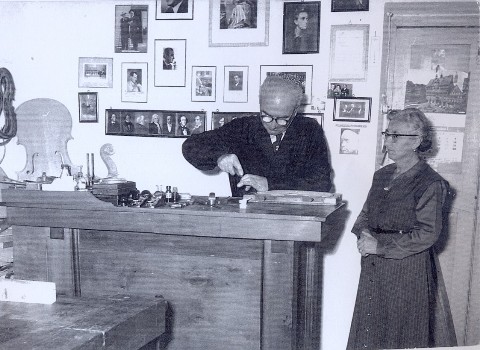
Arturo Fracassi was born to a wealthy family in Sant’Angelo of Gatteo on May 21st, 1899. His father Salvatore, an artisan tailor, emigrated to America seeking his fortune and he returned to Sant’Angelo with a huge amount of material that allowed the family to open a tailor’s shop.
In the period before the war the tradition of music and dance was deeply rooted in Sant’Angelo and often in the village competitions between orchestras took place. As a little boy, Arturo immediately showed a strong interest in music. When he was still living in Sant’Angelo first he was a part of the orchestra ‘Belli’. Later he created his own orchestra. The bass player was the young fellow countryman Secondo Casadei, to whom Fracassi taught the reading of the notes. During this time Fracassi learned to play the violin taking private lessons from Emilio Gironi, a teacher of the municipal music school in Cesena.
Over the years, his interest shifted from music to violin making: in 1919 Fracassi began to attend assiduously the workshop of violin maker Carlo Biondi of Borella. From his first teacher he learned the rudiments of this art even though Carlo Biondi, very jealous of his knowledge (so much that they even had to work on different floors of the same workshop) passed on to him only the minimum required knowledge.
In 1924 he built his first violin relying almost exclusively on his passion and on self-taught techniques on manufacturing, painting and colouring of bow instruments.
In 1925 Fracassi definitively settled in Cesena with his father Salvatore and his sister Paolina and in 1932, after years of engagement, he married Virginia Balestri. In the early years in Cesena, the passion for the “played music” drove him to set up a good orchestra, The “Fracassi-Cesena”. After a few years, the dilemma between music player or violin maker was resolved in favour of the latter. In the decade 1926 – 1936 violas, violins, cellos and a large amount of bows were built by his more and more expert hands.
The correspondence between Arturo and his buyers demonstrates his innate talent and confirmed that Fracassi had been, worldwide, one of the best manufacturers and repairers of arches, which were sought by renowned musicians. To repair the most of these prestigious instruments he designed and built special tools, which allowed him to work on them without damaging them.
The 50’s was the golden age for master Fracassi, both artistically and professionally. Here are some of the many awards and honours that were conferred on him in those years:
– Rome, 1952 – National competition of contemporary violin-making – Silver Medal “Accademia Santa Cecilia”;
– Rome, 1954 – Association A.N.L.A.I. – Silver Medal “Accademia Santa Cecilia”;
– Cesena, 1956 – XII Week of Cesena – Gold Medal of Arts and Crafts;
– Rome 1956 – 3rd National competition of contemporary violin makers – Gold Medal “Accademia Santa Cecilia” for violin ‘Luisa 5257’;
– Florence, 1957 – Fair Market National – International crafts – Gold Medal and Diploma of Honor for violin.
In 1959 Arturo Fracassi left Cesena and moved with his family to Rimini where he died on June 24th, 1973.
As a testimony to his bond with his home town, thanks to a bequest from him, the ‘A. Fracassi’ Welcome Home was established in Sant’Angelo di Gatteo in 1996.
In 2005, Sant’Angelo dedicated to the master luthier the main square.
Since 2014, Park Zaccagnini hosts a “Casa dell’Acqua” (a public freee supplier for tap water) decorated with pictures of some notable people of Gatteo, inclunding Arturo Fracassi.
Edoardo Maurizio Turci of Sant’Angelo, researcher and scholar of local history, published in 1999 a biography of the fellow countryman Arturo Fracassi: “Arturo Fracassi liutaio”, published by “Il Ponte Vecchio”.
Dozens and dozens of violas, cellos, but above all violins, are still played by great musicians and distinguished professors of orchestra. Many of them are carefully preserved in major museums. Since 2001 the Museum for musical instruments of Cesena hosts the first violin made by Fracassi, the viola called “del Trio” built in Cesena in 1939, the only survivor of a trio comprising also a violin and a cello. The latter two instruments were lost perhaps during the passage of the war front. Various tools used by the master for the construction and repair of instruments are also exhibited.
The photos and some of the content of the information are taken from the following publication:
Turci, E. M. “Arturo Fracassi liutaio.” Il Ponte Vecchio, Cesena, 1999.
